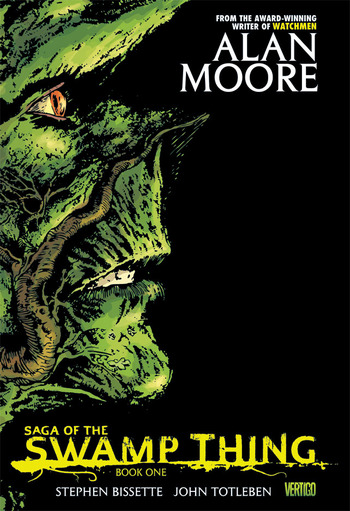My first experience with Swamp Thing wasn’t through the comics. It was a Saturday morning cartoon that ran for a short while in the early nineties. In that show, the opening sequence for every episode explained Swamp Thing’s origin. The scientist Alec Holland became the Swamp Thing through a freak accident. He was experimenting with a “bio-restoritive” formula that could create plant life in the most extreme conditions when a bomb, planted by some nefarious characters, exploded in his lab. The force of the explosion tossed Holland, who was covered in his bio-restorative formula, into the nearby Louisiana swamp. The result was Swamp Thing. Part man. Part plant.
This origin story is what I thought of every time I heard Swamp Thing mentioned while growing up (which wasn’t often). It wasn’t until I was in graduate school just a year or so ago that I heard about Alan Moore’s run on Swamp Thing. In fact, it was my graduate advisor who had some original artwork from the comics on the wall of his office. It was a preliminary sketch for the cover of issue #56. When I showed some interest, my advisor highly recommended Alan Moore’s run on the series.
 Warning, Spoilers Ahead:
Warning, Spoilers Ahead:
One of the most fundamental changes Moore (Watchmen, League of Extraordinary Gentlemen, From Hell, etc.) makes to the Swamp Thing mythos is an alteration to the character’s origin story. In issue #21, he reveals that, while all along Alec Holland and the rest of us have assumed that he’s half man half plant, the truth is that Holland died on the night of the explosion in his lab. The reason the Swamp Thing believes he’s Alec Holland is because Holland’s consciousness, due to the bio-restorative formula, was absorbed by the plant life in the surrounding swamp. From absorbing Holland’s consciousness, the plant life assumed it was human and made itself into a shape that reflected human anatomy. Moore reveals all of this through a brilliant scene involving an autopsy of the believed-to-be-dead Swamp Thing. The character performing the operation soon realizes that all of the Swamp Thing’s leafy organs were never functional.
Once Swamp Thing realizes he’s not actually human at all and he can never return to a fully human existence, he starts to question his place in the world. At one point, he even puts roots down into the ground and intends to give up on even acting human. He just wants to become truly one with the swamp.
As the story continues, Moore probes deeper and deeper into the question of how Swamp Thing can hold onto his humanity even when he’s not human. As my graduate advisor pointed out, Moore also asks similar questions with Doctor Manhattan in the graphic novel Watchmen. All in all, by asking this fundamental question, he pulls the reader into some deep waters that I don’t believe anyone would ever expect to go into with a Swamp Thing comic.

Moore brings some masterful writing to this series that turns it into a thought-provoking and philosophical piece of literature. The artwork by co-pencillers Stephen Bissette and John Totleben is also superb. Please check it out if you have any inclination at all. The entire series is out in a series of volumes in graphic novel form entitled Saga of the Swamp Thing.
“SWAMP THING! *duh-nah-nah-nahhh* YOU MAKE MY HEART SING!”
A good intro to the series. I’ll have to check it out!
I read these when they first came out. It’s reassuring to see that a new generation of readers still finds them relevant and entertaining like I did way back when. I still find Saga of the Swamp Thing #21 one of the best individual comics ever made. It has incredible story that is moving and structurally dynamic and complete while the art is well rendered and dynamic as well.
Alan Moore’s Swamp Thing run, his introduction to an American comic audience, is indeed some of the most masterful writing to ever grace the pages of comic books. I actually recommend reading the series from the start so you can see from Alan’s second issue, the first is really just him tying up loose ends from the previous writer ending with the Swamp Thing getting shot, how much of a powerful impact he had right away. The stark difference between the issues that came before, or anything else that was being written at the time, really is quite powerful.
Another thing that doesn’t get mentioned very often is how Alan worked within the existing mythos and any changes he made felt natural. He can (could?) take something with deep roots, a long history and established place in the world and change it so drastically and with such respect and understanding of that history. The result is a completely new creation in a way that never even has the reader think of calling it a ret-con. It almost feels like it was actually a hidden plot element right from the beginning.
If anybody reading this is interested, I suggest searching for the script to “Twilight of the Superheroes,” a mini-series Alan was proposing post-Watchmen right before he left DC. It comes with a several page intro that does drag on a bit in a stream a consiousness manner, but when you get to the script itself, the mystery, and the ‘oh my God’ simple, yet powerful ending, with John Constantine (cutting what I wrote here so as not to even hint at spoiling it.) it will make you cry that it was never finished and published.
Do you have the link to that script? I would love to read it. Glad you appreciate Moore’s Swamp Thing as much as I do!
Twilight of the Superheroes by Alan Moore
Wiki – http://en.wikipedia.org/wiki/Twilight_of_the_Superheroes
Script itself – http://fourcolorheroes.home.insightbb.com/twilightfree.html
As I said, the pre-able is quite lengthy, but the whole thing is worth the read.
preamble
Sorry, no ‘edit post’ option.
Thank you for this!